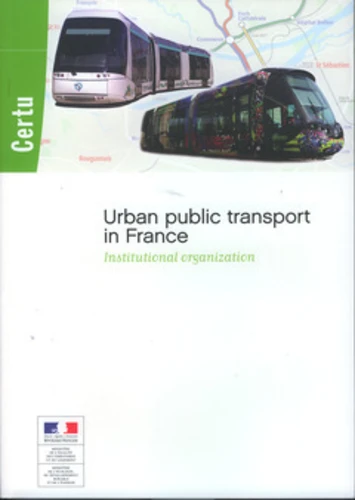Urban public transport in France. Institutional organization
4th edition
Par : Formats :
Définitivement indisponible
Cet article ne peut plus être commandé sur notre site (ouvrage épuisé ou plus commercialisé). Il se peut néanmoins que l'éditeur imprime une nouvelle édition de cet ouvrage à l'avenir. Nous vous invitons donc à revenir périodiquement sur notre site.
- Paiement en ligne :
- Livraison à domicile ou en point Mondial Relay indisponible
- Retrait Click and Collect en magasin gratuit
- Réservation en ligne avec paiement en magasin :
- Indisponible pour réserver et payer en magasin
- Nombre de pages131
- PrésentationBroché
- FormatGrand Format
- Poids0.528 kg
- Dimensions21,0 cm × 30,0 cm × 0,8 cm
- ISBN978-2-11-131052-0
- EAN9782111310520
- Date de parution13/08/2013
- ÉditeurCERTU
Résumé
Around the world, as the demographic weight of urban areas increases, the need to provide all residents with efficient, low-energy public transport has become a major political issue. France has experienced a surge in urban public transport that began in the 1970s. First with the creation of metro lines in the largest cities, then with the launch of many modern tram networks in the Paris region and in medium-sized cities, and, more recently, with the creation of Bus Rapid Transit (BRT) lines when heavy modes were not justified.
To support these development efforts and the use of urban public transport by citizens, an institutional and financial framework has been put in place by governments and constantly improved. The aim of this brochure is to present the organization of urban public transport in France in all its diversity, including ten or so monographs illustrating some original aspects of the practices and know-how of local authorities' (the organizing authorities) and large French passenger transport groups.
We hope that this brochure will shed light on the French system and thereby contribute to sharing experiences in the field of urban transport.
To support these development efforts and the use of urban public transport by citizens, an institutional and financial framework has been put in place by governments and constantly improved. The aim of this brochure is to present the organization of urban public transport in France in all its diversity, including ten or so monographs illustrating some original aspects of the practices and know-how of local authorities' (the organizing authorities) and large French passenger transport groups.
We hope that this brochure will shed light on the French system and thereby contribute to sharing experiences in the field of urban transport.
Around the world, as the demographic weight of urban areas increases, the need to provide all residents with efficient, low-energy public transport has become a major political issue. France has experienced a surge in urban public transport that began in the 1970s. First with the creation of metro lines in the largest cities, then with the launch of many modern tram networks in the Paris region and in medium-sized cities, and, more recently, with the creation of Bus Rapid Transit (BRT) lines when heavy modes were not justified.
To support these development efforts and the use of urban public transport by citizens, an institutional and financial framework has been put in place by governments and constantly improved. The aim of this brochure is to present the organization of urban public transport in France in all its diversity, including ten or so monographs illustrating some original aspects of the practices and know-how of local authorities' (the organizing authorities) and large French passenger transport groups.
We hope that this brochure will shed light on the French system and thereby contribute to sharing experiences in the field of urban transport.
To support these development efforts and the use of urban public transport by citizens, an institutional and financial framework has been put in place by governments and constantly improved. The aim of this brochure is to present the organization of urban public transport in France in all its diversity, including ten or so monographs illustrating some original aspects of the practices and know-how of local authorities' (the organizing authorities) and large French passenger transport groups.
We hope that this brochure will shed light on the French system and thereby contribute to sharing experiences in the field of urban transport.






